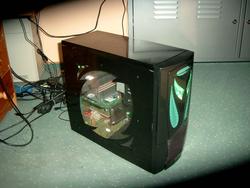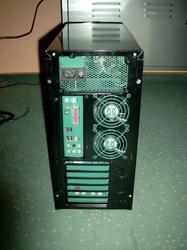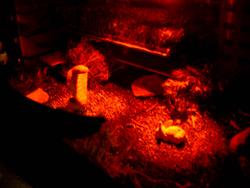My Custom-built and Modded PC
You are reading an older blog post. Please be aware that the information contained in it may be technologically outdated. This text may not necessarily reflect my current opinions or capabilities.
This is an English translation of a blog post that was originally published in German.
April 25th, 2007
Far away from computer shopping catalogues and case modding forums, some visitors may be surprised to find an article here dedicated to my PC – ostensibly a commodity device. Other visitors (who know me well) may not be surprised at all. So what's all this?
To begin with, a PC is a tool with which you can do tasks. Of course, you can examine any tool and wonder how it works. In the case of the PC, this reveals a sophisticated interplay of individual components that interact with each other in a rather precisely defined way. You can change things everywhere, rebuild things, swap parts. The inside of a PC has an aesthetic all of its own, which is probably most readily recognized and enjoyed by those who have developed a routine in taking PCs apart and putting them back together again. At some point, someone dared to ask why it was necessary to put a fig leaf (in the form of a beige metal case) on this structure. This question forms the cornerstone of case modding: the computer is perceived as an end in itself and advances to become an object of craft and perhaps even art.
As someone who uses his PC a lot, I couldn't resist taking my creative energy out on it as well. The result can be found here.
Hardware
I'll let the (almost) complete list speak for itself:
- Mainboard: ASUS A8N-E
- CPU: AMD Athlon 64 3200+ (Venice)
- RAM: MDT 2048MB DDRRAM PC400 TwinPack 2x1GB
- Graphics: EVGA e-GeForce 7600GS PCI-E 256MB Passive
- Network: Realtek RTL8139C(L) 10/100Mbit/s Fast Ethernet PCI
- Hard drives: Samsung SpinPoint P120, SP2504C, 250GB; Maxtor DiamondMax 6Y160P0, 160GB
- CD/DVD: NEC ND-3550A
- Monitor: BenQ FP71V+ 17" 4ms TFT
- Keyboard: Logitech Deluxe 250
- Mouse pad: Revoltec Lightpad Precision (Green Edition)
- Printer/scanner: Canon PIXMA MP500
- Speaker: Creative Inspire 280
The Case
My case is a Raidmax Cobra in the color combination black-yellow. I fell in love with the look of the case at first sight – this and no other had to be it.

The case is pleasant to handle. Due to the fact that it is stainless steel, it is quite heavy, but the height of only 42cm makes it easy to transport (if you compare it to the big towers which are currently in fashion…). The front connector (USB and sound) placement is a bit unfortunate at the lower base, the flap can hardly be opened properly. Furthermore, the Cobra unfortunately only offers space for 80mm fans – which is bad for the noise volume.
I ultimately made the following changes to the case:
- I disassembled the front to replace the LEDs (the “eyes” are simple plexiglas bodies) with ultra-bright green ones and also painted the yellow area green.
- I also replaced the plexiglass pane of the window with one without a fan hole – side fan holes are counterproductive for airflow anyway. My airflow is ATX compliant from the bottom front to the top back and gets past all the major components that need cooling. Aside from that, a fan on the side would have significantly increased the noise level and blocked the view of the inside of the case.
- The yellow perforated grill was replaced with proper dust filters.
- In addition to these dust filters, I covered the lower part of the front (the one with the vents) with black fabric because I'm a lazy person. So the dust collects right outside and I don't have to open the case to clean it. :) Besides, the look suits me quite well, too. With this, I have a two-stage dust filtration system and hope that the air inside the case stays relatively dust-free. Consequently, I sealed the air holes in the left side of the housing from the inside with tape.
There are a total of three fans working in the case: The one of the power supply (temperature-controlled) and two 80mm fans of the type Papst 8412/N2GLE regulated to 5.2V. More about this in the following section.
Cooling and Noise
My cooling concept (thanks for help and case studies to the community of silenthardware.de) is based on a passive cooling approach inside the case to reduce air turbulence and noise level and to enable efficient heat dissipation through sensibly used case fans.
I cool the CPU with a Scythe Ninja, which in passive mode (without a fan) is of course completely silent. I replaced the small 40mm vortex fan on the chipset with a Thermalright HR-05. On the nForce4 chip, it gets darned warm in continuous operation (I wouldn't want to touch it for more than a second), but it seems to do its job well. The graphics card is already passively cooled, so it didn't need any further attention.
The Seasonic power supply with the built-in 120mm fan and two decoupled Papst 8412/N2GLE fans in the rear provide ventilation. These initially ran at full speed for testing. When it became apparent that all temperatures were in the dark green range, I regulated them down to 5.2V with a homemade fan controller (the super simple LM317 fan control from modding-faq.de). This crooked value came about because I did not have a precise scale with the control at first. So I set the fans to a value somewhere just above the starting voltage and then measured the voltage afterwards.
The fan in the PSU produces a virtually inaudible noise and thus passed my quality test. The two Papst-brand fans unfortunately produce a clear motor clacking even at low operating speeds. When the case is closed, it is only only noticeable within a distance of 30cm, but maybe I'll exchange them for quieter fans, we'll see.
All three fans blow the air out the back of the case. Because I didn't want to install superfluous fans in the front, I sealed all case openings (especially the ones on the sides, see the previous section), so that air is only drawn in through the vents at the bottom front. This creates the desired airflow.
If you're a hardcore gamer used to PCs at vacuum cleaner volume, you might hardly believe that this concept works. But it does: Even under full load, the graphics card only gets above 40°C at most, the CPU stays pleasantly cool, and the motherboard's temperature sensors only show temperatures in the 30s. Maybe a few degrees more in summer, we'll see.
Front Panel and Diorama
In an unused 5¼ inch slot, I placed my own front panel. This contains a USB socket, four rocker switches for the LED lighting (1. front, 2. inside green, 3. inside orange, 4. off switch for the status LEDs), a lock for my self-designed data safe, and four status LEDs for power, hard drive activity, network activity, and the data safe (open or closed).
For the data safe, I cut open a USB cable and soldered the data lines to subminiature relays, which are switched by a key switch in the front. A USB stick is connected to the modified USB cable inside the case. This actually works reliably and gives a wonderful, unhackable (because of the physical disconnection) storage for important data. I carry the key for it on my keychain as normal. I couldn't find any evidence that anyone had implemented anything quite like this before me.
All circuits and boards as well as the USB stick fit inside a cannibalized CD drive, to which the custom front panel is glued. The light modules are connected to the drive via a hollow connector (chosen instead of a pin header because of reverse polarity protection), likewise a hollow connector socket is soldered to the network card. The lighting (especially the function of the first three rocker switches) is thus modular.
In the rear area (by the PCI cards) I built an atmospheric, suspenseful nature scene to match the case. A piece of astroturf serves as a base on which two animal figures, a cobra and its prey, are placed. Around it, some moss and several stones are placed as a landscape.
The separate lighting (one spotlight each on cobra and prey) in contrasting color (orange) from the rest (green) creates distance between the two worlds, and I even made sure that the two colors intrude into each other's area as little as possible. On the other hand, the PCI cards and chipset cooler are present, creating a fluid aesthetic between nature and technology. A hybrid world? Or just a theatrical backdrop after all? The interpretation is up to the observer.
The hunter-prey tension is clearly visible in the build, as the cobra and the rabbit look each other in the eye. All of this fits with the case itself, which already displays an aggressive aura with its cobra symbolism.
German Case Modding Championship 2007
With the finished PC I headed to Dortmund for the weekend of April 21 and 22 as a participant in the German Case Modding Championship 2007. I was able to meet a lot of interesting and competent people, exchange experiences, and altogether have a lot of fun together. Unsurprisingly for me it was not enough for a place on the podium, but it was still a wonderful experience.







Comments
You can leave a comment by replying to this Mastodon post from your own account on Mastodon, GoToSocial, Akkoma, or any other ActivityPub-capable social network that can exchange replies with Mastodon.